You are reading the older HTML site
Positive Feedback ISSUE
46november/december 2009
paramount technology
Zeeba Universal Speaker and Component Stand
as reviewed by Kent Johnson
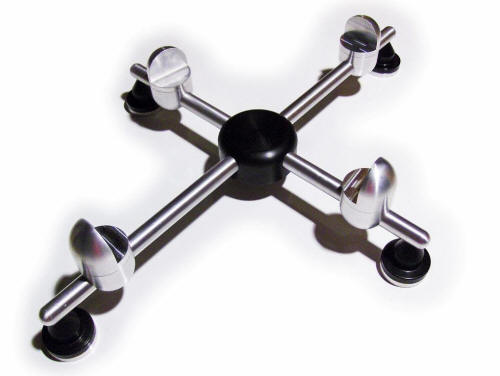
[All photographs below by Kent Johnson]
|
KENT JOHNSON'S SYSTEM
LOUDSPEAKERS
ELECTRONICS
SOURCES
CABLES
ACCESSORIES SECOND SYSTEM
LOUDSPEAKERS
ELECTRONICS
SOURCE
CABLES
ACCESSORIES
|
I don't know about normal people, but when I read the name Zeeba, I find myself wanting to add the word "neighba." I guess that will happen when reading the comic page provides the day's dose of literary culture.
The Zeeba we are interested in here is a "universal vibration control platform for high quality audio equipment." It is suitable for any component but was developed primarily for use with components that sit on the floor—speakers and amplifiers. I saw and heard these Zeeba stands in several rooms at Rocky Mountain Audio Fest 2009.
Theory
The Zeeba stand is designed and built by Abbas Nourollahi; he has a Masters degree in mechanical engineering. His background is in vibration analysis in the design of turbine engines. He is also a music lover. Here is his description of how the Zeeba stand functions:
"My years of experience as a scientist, and being a music lover, brought me to focus on the effect of the ‘flooring factor' on sensitive audio equipment, especially loudspeakers, amplifiers, and turntables. After intensive research, I developed and patented the Zeeba, which dampens vibrations close to zero and isolates the system to prevent resonation from the floor which distorts the sound.
In practice, the Zeeba works the opposite of what has been conventional wisdom in dealing with vibration issues in audio components. Speakers and amplifiers are typically supported, directly or indirectly, by cones/spikes that are driven down into the floor. The cone minimizes the contact between the component and the supporting surface and works to drain off vibrations.
This set up has its potential drawbacks, however. If you have nice wood floors, you don't want to ruin them with scratches and holes; it is questionable whether this set up does any real good on hard floors like marble or stone; with carpets, the cones may or may not pierce through the carpet into the subfloor, in which case, they are doing nothing. It also provides little protection from footfalls.
With the Zeeba, the benefits of using cones are preserved as they form the only points of contact between the Zeeba frame and the flooring material. The difference is that the cones point upward. Each of the four cones contacts the self-dampening aluminum Zeeba frame over an area of only .005 of an inch, isolating it from the floor. The flat surface of each cone spreads the load over a wide enough area that even the heaviest component is unlikely to damage the supporting surface.
The Zeeba stand is offered in two basic versions: a 90 degree stand and a 70 degree stand. Two different angles between the arms are offered to accommodate the design and layout of different components. I received a 70 degree stand for review. Each Zeeba stand sells for $475.
Zeeba Assembly
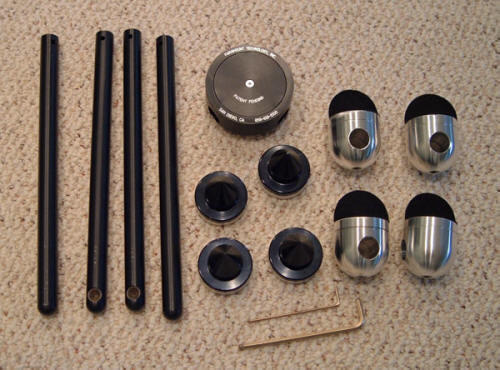
The Zeeba parts on parade
Assembly starts with a central plate into which the four supporting arms are inserted. Hardened steel pins in the plate lock the arms in place leaving only very minimal play. (The unit I reviewed was clearly a demo; there is probably even less play in a new unit.)
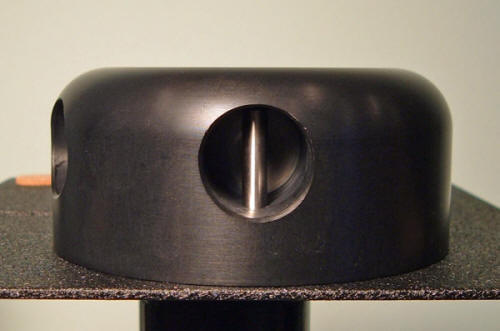
Zeeba hub, showing its pin
Four upper seats, each with a 90 degree cutout, actually support the component itself. These seats can rotate through 360 degrees on their supporting lower seats. These seat assemblies can be located anywhere along an arm. The 90 degree cutout on the upper seat is lined with a felt material that avoids scratches. The cones, which are adjustable for height, fit into hardened depressions at the ends of the arms. The quality of the machining and fit of the parts is exemplary. The Zeeba exudes elegant design and engineering.
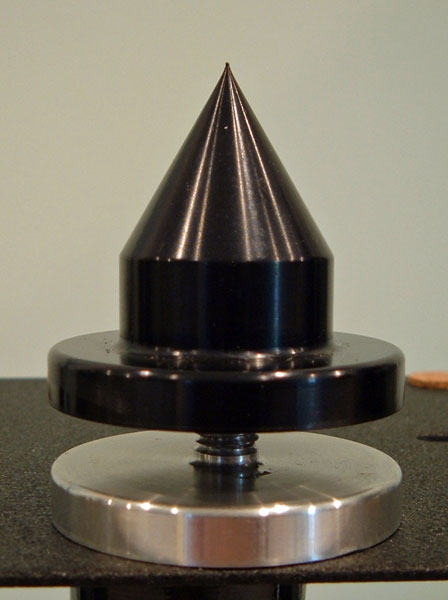
The Zeeba adjustable cone
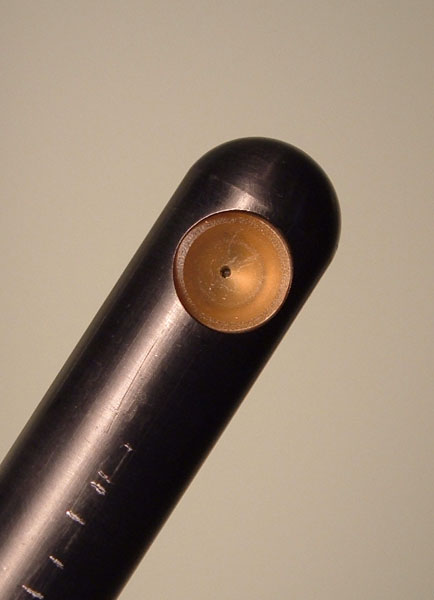
A photograph of the cup at the end of the Zeeba arm
Assembling the Zeeba stand requires only two Allen hex wrenches, which are included. Putting it together takes only minutes. Deciding how to orient the component/speaker on the stand takes a little more thought. The location of the input/outputs jacks on the back of a speaker or amplifier is going to determine just where the upper seats can be located.
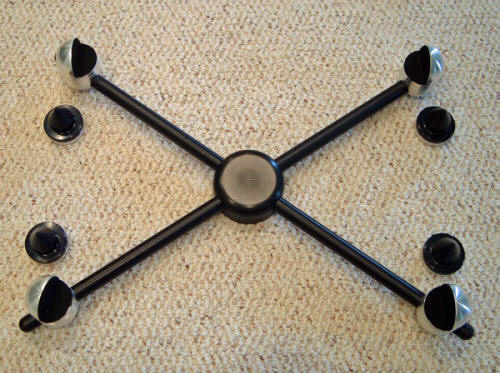
The stand-off of the Zeeba cones, showing the component frame
I had to orient the frame different ways with each of the amplifiers I used—my Rogue Stereo 90 and a Hegel HT100. The rear jacks on the Hegel left no usable flat surface for the upper seat to contact, so I located all the seats on the amplifier's sides. This set up can create interference problems with a component's feet. Fortunately, in the Hegel's case its feet cleared the arms of the Zeeba stand. With some audio components, it may be necessary to remove the stock feet.

The Hegel HT100 in place on the Zeeba stand
With my Rogue Stereo 90 amplifier, it was possible to support it on all four sides. Due to the weight of the transformers, I moved the amp as far forward on the stand as I could; this placed three of the seat assemblies under the rear half of the amplifier.
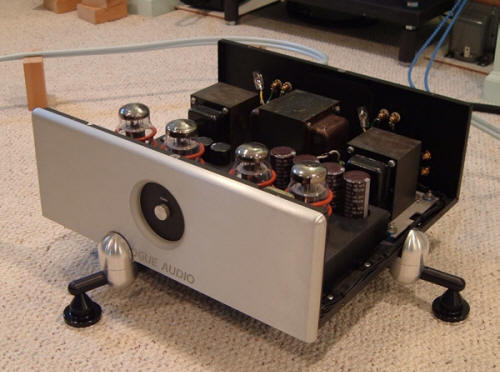
My Rogue Stereo 90 amplifier on the Zeeba stand
Installing the Amp on the Zeeba Stand
I found that by putting the frame on the floor, off of the cones, the floor held the seat assemblies in position. I left the Allen set screw in the bottom of each lower seat, which locks it in position, just loose enough that I could move the seat assemblies along the arms. I then positioned the upper seats on the arms just slightly wider/longer than the amplifier itself.
Once the amplifier was placed upon the upper seats, its weight held them in position. I then placed the cones under the arms. Once up on the cones, it was possible to tighten the seats in position using the Allen wrench. Working alone, this system worked fine with the two amplifiers. For speakers, I would definitely want at least one more person, a person who could readily lift the speaker alone, for help in placing it onto the stand.
Listening
My normal amplifier support is an inexpensive Sanus stand spiked through the carpet of my basement listening room to the concrete floor below. With the Zeeba in its place, I first listened with the Hegel amplifier. The Hegel had sat upon the Sanus stand during the entire period of its review, providing a good basis from which to evaluate the Zeeba.
I listened to a CD by Nina Rambsby and the Ludvig Berghe Trio (Moserobie MMPCD 862). This is a Swedish jazz CD of spectacular sound quality, which proved extremely helpful in hearing the subtle changes effected by the Zeeba stand.
I heard a slightly improved sense of focus throughout the spacious soundstage with the Hegel/Zeeba combination. This could be heard in a more tactile sense of fingers touching the strings of the bass violin and in the clarity and sense of space surrounding the drum kit at the back of the stage. The sonic improvement was like an already extremely attractive woman changing into a slightly more flattering dress. The basics were unchanged, but there was something more attractive about the overall effect. This proved true of the other CDs I listened to as well.
There was a more pronounced improvement in the sound of my Rogue 90 amplifier on the Zeeba stand, which I don't think should be too much of a surprise. I tend to view tube amps as having inherently more vibrations happening within them (whether actually true or not), and also as being more susceptible to external vibrations than solid-state equipment.
I turned to several tracks from The Swell Season's live CD, An Evening at the Riverside Theater, which I had used heavily in reviewing the Hegel HT100 amplifier.
Here, the Zeeba revealed more of the atmosphere around the voices, tighter bass, and greater intelligibility in the lyrics. The last of these improvements might seem trifling unless, like me, you have to turn on the closed captioning of most Irish movies. The children's choir on Track 7, "Falling Slowly," was better defined within the soundstage and individual voices were clearer without damaging the overall loveliness of the voices as a group.
Joshua Bell's CD, At Home with Friends (Sony Classical 88697 58979 2), touches upon a lot of different musical styles. Again, the placement of the voices and instruments within the soundstage was better organized. I also thought that Kristen Chenoweth's voice came through more clearly and naturally on "My Funny Valentine."
These enhancements were consistent with the other music that I listened to.
Summary
The Paramount Technology Zeeba universal stand did offer subtle improvements to the sound of my system over that of my reference stand, even though it was well-anchored to the floor beneath it. I would expect far more audible improvements from the Zeeba stands with speakers than other components, and from any component placed on a less solid floor than concrete.
At $475 per stand, the Zeeba is very competitive with other platforms and stands on the market. It also offers features that some of its competitors may not. First, each cone can be adjusted for height. With my listening room floor, this is a significant plus. Used with a tube amplifier, the Zeeba offers far better ventilation than any solid platform. This is not a trivial advantage; better convection flow means that expensive output tubes perform better and last longer. Depending on the tubes, the price of a Zeeba stand may not take long to recapture. For the audiophile who has already spent significant money on an amplifier and speakers, the actual cost of a Zeeba will represent only a fraction of that investment, but may very well help those components realize their full capabilities by making them less floor-interactive.
The Zeeba is a beautifully made example of form-following-function. Based on what I have heard, I certainly recommend auditioning this stand. How well it performs will depend on the floor and components involved, but I feel certain that the results will be positive, and will probably better than you might expect. Kent Johnson
Zeeba Universal
Speaker and Audio Component Stand
Retail: $475 each
Paramount Technologies,
Inc.
Abbas
Nourollahi
16740 W. Bernardo Drive
San Diego, CA 92127
TEL: 858-618-1500
email address:
[email protected]
web address:
www.Paramount1.us


